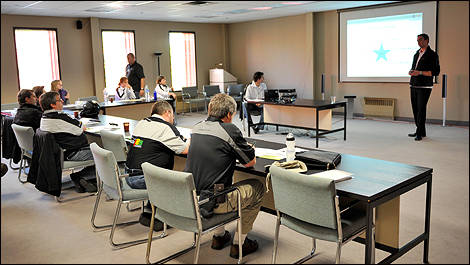Blainville, Québec - It's a well known fact that the greenhouse gasses (GHG) produced by vehicles have become enemy number one of the Minister of the Environment, Jim Prentice. In fact, on April 1st he announced the adoption of new regulations that will "be very effective in helping transform our automotive sector and making it greener."
In March 2007, well before this announcement, Transport Canada had already established the "ecoTechnology for Vehicles" program (eTV for the initiated). Dealing exclusively with passenger vehicles, the program's mission is to enable Canadians to discover new technologies capable of reducing the emissions responsible for GHGs.
"For changes to take hold, it is often necessary to break down the barriers erected by consumers," says Patricia Procter, Vehicle Program Manager at Transport Canada. "To convince them to change their consumption habits and use new technologies, we must first introduce and explain these technologies."
Auto123.com met with Ms. Procter and the eTV team during an exclusive information session held at the PMG automotive test and research centre in Blainville, north of Montréal.
We learned that the program was created to help the public understand and assimilate modern transport methods, which use advanced technologies that help reduce GHGs and other harmful emissions. Technologies that, in several cases, also help reduce fuel consumption.
Cars are not the only guilty party
To understand eTV's mission and fully appreciate the program, we need to put things into context. According to Environment Canada's specialists, after stationary sources (electrical energy, steel and metals, residential wood heating, etc.) the transportation network is responsible for a little over 27% of GHGs.
That's about half of what stationary sources produce. In addition, under the transport network heading specialists classify private and commercial vehicles, off-road engines as well as rail, air and sea transport.
 |
| Auto123.com met with Ms. Procter and the eTV team during an exclusive information session. |
In March 2007, well before this announcement, Transport Canada had already established the "ecoTechnology for Vehicles" program (eTV for the initiated). Dealing exclusively with passenger vehicles, the program's mission is to enable Canadians to discover new technologies capable of reducing the emissions responsible for GHGs.
"For changes to take hold, it is often necessary to break down the barriers erected by consumers," says Patricia Procter, Vehicle Program Manager at Transport Canada. "To convince them to change their consumption habits and use new technologies, we must first introduce and explain these technologies."
Auto123.com met with Ms. Procter and the eTV team during an exclusive information session held at the PMG automotive test and research centre in Blainville, north of Montréal.
We learned that the program was created to help the public understand and assimilate modern transport methods, which use advanced technologies that help reduce GHGs and other harmful emissions. Technologies that, in several cases, also help reduce fuel consumption.
Cars are not the only guilty party
To understand eTV's mission and fully appreciate the program, we need to put things into context. According to Environment Canada's specialists, after stationary sources (electrical energy, steel and metals, residential wood heating, etc.) the transportation network is responsible for a little over 27% of GHGs.
That's about half of what stationary sources produce. In addition, under the transport network heading specialists classify private and commercial vehicles, off-road engines as well as rail, air and sea transport.
 |
| According to Environment Canada's specialists, after stationary sources, the transportation network is responsible for a little over 27% of GHGs. |


